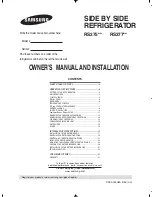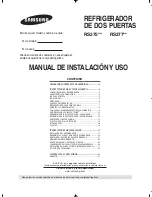
.. Please Read Carefully.
Use of adapter plug
Because of potential safety hazards
under certain conditions, we
strongly recommend against use of
an adapter plug. However, if you
still elect to use an adapter, where
local codes permit, a TEMPOWRY
maybe made to a
properly grounded two-prong wall
by use of a
listed adapter
(Fig. 2) available at most local
hardware stores.
I
TEMPORARY
(ADAPTER PLUGS NOT
IN
ALIGN LARGE . ,
Fig. 2
P
RONGS
/
SLOTS
%
INSURE PROPER
AND FIRM CON
NECTION
BEFORE USE
The larger
in the adapter must
be aligned with the larger slot in the
wall outlet to provide proper polarity
in the connection of the power cord.
CAUTION: Attaching an adapter
ground terminal to the wall outlet
cover screw does not ground the
appliance unless the cover screw is
metal, and not insulated, and the
wall outlet is grounded through the
house wiring. You should have
circuit checked by a qualified
electrician to make sure the outlet
is properly grounded.
When disconnecting the power
cord from the adapter,
always hold
the adapter with one hand. If this
is not done, the adapter ground
terminal is very likely to break
with repeated use.
Should the adapter ground
break, DO
USE the
appliance until a proper ground
has again been established.
Use of
cords
Because of potential safety hazards
under certain conditions, we
strongly recommend against the
use of an extension cord. However,
if you
elect to use an extension
cord, it is absolutely necessary that
it be a
listed 3-wire grounding
type appliance extension cord having
a grounding type plug and outlet
and that the electrical rating of the
cord be 15 amperes (minimum) and
120
Such extension cords are
obtainable through your local
service organization.
The refrigerator should
always be plugged into
own
individual electrical
(115
volt, 60 Hertz, or 100 volt,
50 Hertz, single phase AC). This is
recommended for best performance
and to prevent overloading house
wiring circuits, which could cause a
fire hazard from overheating wires.
Refrigerator location
Install the refrigerator
a floor
strong enough to support it when
it is fully loaded.
Do not install refrigerator where
temperature will go below
because it will not run often enough
to maintain proper temperatures.
Also see Energy-Saving Tips
regarding location.
Clearances
Allow the following clearances
for ease of installation and proper
air circulation:
Sides. . . . . . . . . . . . . . . . . . . . 3/4”
Top . . . . . . . . . . . . . . . . . . . . . . 1“
Back. . . . . . . . . . . . . . . . . . . . . 1“
If refrigerator is to be installed
against a wall on the hinge side,
allow
for door clearance.
Water supply to
You
will need to connect your
to a cold water line. A
water supply kit containing copper
tubing, shutoff
fittings and
instructions is available at extra
cost from your dealer. There
should be sufficient tubing for the
from the cold water supply
to allow moving the refrigerator
out from the wall several feet
(approximately 3 coils of l/4-inch
copper tubing that measures at
least 10 inches in diameter).
4
Rollers
Adjustable rollers,
which enable
you to move the refrigerator away
from the wall for cleaning, are
located near the front corners of the
refrigerator. Set these rollers so the
refrigerator is firmly positioned on
the floor and the front is raised just
enough that the doors close easily
when opened about halfway.
II
To adjust the rollers,
turn the
adjusting screws clockwise to
raise the refrigerator, counterclock-
wise to lower it. Use a blade-type
screwdriver.
adjusting front rollers for proper
door closure, we recommend that
the bottom front edge of the cabinet
be approximately 3/4” from the floor.
You can turn the adjusting screws
through openings in the base grille.
I
I
I
you would rather remove the
base grille,
grasp the bottom of the
grille and pull it out.
To replace the base grille,
lineup
the clips on the back of the grille
with the openings in the baseplate
and push the
forward until it
snaps into place.


































